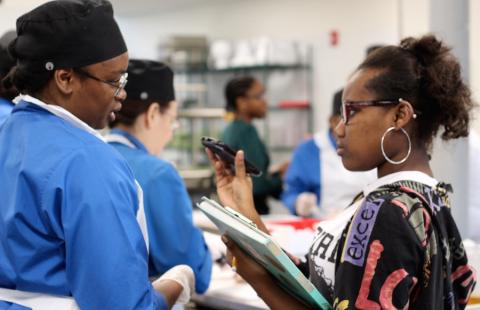What were the specific goals of this creative economy project? Describe the community development challenge or opportunity that your project was designed to address:
For eight weeks beginning in April 2018, The Arts Paper paper contracted with seven teen correspondents, enrolled at Cooperative Arts & Humanities (“Co-Op”) High School, to each produce three original short-form articles on New Haven’s arts and culture, as well as a feature-length, 1,200-2,000 word capstone. For their four contributions, The Arts Paper paid the YAJI teens a stipend of $400—its regular print freelance rate of $100 an article—and comped them travel and work expenses.
The decision to collaborate with the “YAJIs” as fully-fledged freelancers was not just a vague commitment to pay equity in the arts. It was an honest admission that The Arts Council and The Arts Paper stood to benefit from a public program like YAJI. It was also a frank recognition of the fact that the YAJIs were already total pros before they ever met our team. The Arts Paper could not possibly “train” the YAJIs, but was merely there to bring the print and the professional development. The latter took the form of a five-day intensive at the very start of the program, where the YAJIs met with representatives from nine New Haven arts organizations and media outlets for conversations and hands-on practicums.
The intensive was an opportunity to expose the YAJIs to a broad cross-section of creative and common-good careers. Some of the YAJI teens entered into the program as strong writers, but others entered as violinists, or on the recommendation of their science teachers. While some YAJIs might choose to keep developing their ability to craft clear and thoughtful copy, it was crucial that the entire experience open doorways.
If the goals change over time, please describe how:
In year one of the program, facilitators Lucy Gellman and Stephen Urchick found that expectations had to be tempered—sometimes the learning and article writing process was more important than the finished product itself. While our goals for the program remained focused on four finished pieces in the short term and workforce development and sustained mentorship in the long term, both facilitators realized that students who did not "finish" in the traditional sense had not failed. The Arts Paper also found itself expanding definitions of media, from traditional articles to podcast, videos, and radio interviews.
Who was involved in this project and what did they do? (be sure to include the partners from outside of the creative sector and how local voices were included):
The founders of the project were Stephen Urchick, now a graduate student in the History of Art at Yale University, and Arts Paper Editor Lucy Gellman (who is still acting editor and point person on YAJI 2019). Community partners included local journalists Markeshia Ricks of the New Haven Independent, Diane Orson of Connecticut Public Radio/WNPR, and Sumorwuo Zaza formerly of Huffington Post; dramaturg Madeline Charne at the Yale School of Drama; Reverend Kevin Ewing of Baobab Tree Studios. Institutional partners also included Co-Op High School, the Yale University Art Gallery and Yale School of Drama, Gateway Community College; and the Connecticut Center for Arts and Technology (ConnCAT), which allowed students to observe and cover its 2018 culinary cohort.
How does this project relate to a larger community development strategy?
The Arts Council of Greater New Haven sees YAJI as contributing to sustained workforce development and mentorship with a genuine commitment to equity, access and inclusion. We are creating a wave of journalists of color in a field that is not diversifying as fast as we would like it to.
What projects or places, if any, inspired your approach to this creative economy project?
We were inspired by Chicago's "South Side Weekly" (https://southsideweekly.com/), a nonprofit newsprint magazine and radio show dedicated to supporting cultural and civic engagement on the South Side, and to providing educational opportunities for developing journalists, writers, and artists. However, the South Side Weekly is produced by an all-volunteer staff. It was important to us to empower our writers through compensation.
